Minimum TOEFL / IELTS Score to Study in Europe


Pingin melanjutkan studi di Eropa? Jangan lewatkan EHEF Indonesia 2019, pameran pendidikan tinggi Eropa terbesar di Indonesia yang paling dinanti-nanti!
Surabaya 31 Oktober 2019
Jakarta 2 - 3 November 2019
Bandung 5 November 2019
Registrasikan dirimu di sini! Acara ini GRATIS!
By Mia Angeline
Thinking about having a degree from a reputable university in Europe is exciting, but it may be daunting too.
The first big challenge to tackle is the language requirement.
European universities nowadays offer many programs in English so you will want to make sure that you pass the TOEFL or IELTS exam.
You may wonder,
‘will my TOEFL / IELTS scores be good enough to study in Europe?’
‘what are the minimum TOEFL / IELTS requirements to get me into the best university programs?’
Now, do not worry since we are here to help. We have compiled a list of minimum TOEFL / IELTS scores that the best European universities will accept.
Find the list of scholarships to study in Europe, here.
TOEFL vs IELTS
However, before we get on to the list, you probably need to know the differences between TOEFL and IELTS.
As you know, both of the exams are designed to measure the English proficiency of a person in four skills, from Reading, Speaking, Writing, and Listening.
First, TOEFL stands for Test Of English as a Foreign Language. Since TOEFL is administered by US-based institutions, this test is favored by American institutions. There are two types of TOEFL exams, the paper-based test (PBT) and the internet-based test (iBT). TOEFL PBT has a score between 310 to 677, while iBT has a scale of 80 to 120.
TOEFL exam questions mainly consist of multiple choice, so you need to think analytically to weigh up the difference between options. TOEFL test takes approximately four hours to complete.
The main differences between TOEFL and IELTS can be found in the Writing and Speaking sections. While TOEFL PBT does not have a Speaking exam, in TOEFL iBT, the Speaking section requires you to answer six questions into a microphone to be recorded and later sent to reviewers. As for the writing section, you need to write two essays, a five-paragraph essay, and a 150-225 word response.
On the other hand, IELTS stands for International English Language Tests. You may want to notice that IELTS uses British English, and is believed to be favored by most European universities (especially the United Kingdom), also by universities in New Zealand and Australia. To complete an IELTS test takes approximately 2 hours and 40 minutes. IELTS requires you to respond to a range of different question types, not just multiple choice. IELTS has a band system score from 1 to 9.
IELTS Writing section requires you to complete two tasks. The first task is to explain the information in a graph or chart, and later you will need to write a 200-250 word response. While on the Speaking session, you need to speak directly face-to-face with an examiner – a real person, not a computer.
Also read: Guide to Effective TOEFL and IELTS Preparation
Minimum Score Required
Now that you are familiar with TOEFL and IELTS, let’s see the minimum score required by universities in Europe:
TOEFL PBT 550 or iBT 79-80:
TOEFL PBT 575 or iBT 90:
TOEFL PBT 600 or iBT 100:
- University of Luxembourg
- Masaryk University
- Radboud University, Netherlands
TOEFL > 600 PBT or > 100 iBT:
IELTS 5.0:
IELTS 6.0:
- Wageningen University and Research, Netherlands
- International Business School, Hungary
- Coventry University, UK
IELTS 6.5:
- Utrecht University, Netherlands
- Durham University, UK
- John Cabot University, Italy
- University of London, UK
IELTS > 6.5:
Find the list of universities in Europe, here.
As you can see, the expected level of English may vary according to the university.
But it is safe to conclude that the average English language needed to study in Europe is 550 – 580 for TOEFL PBT, or 79 – 95 for TOEFL iBT, and 6.5 to 7.0 for IELTS test.
Keep in mind that language requirement is one of the challenges you must tackle, and the university may consider other factors, such as your GPA or motivation letter. Also, don’t get discouraged if you don’t meet the minimum criteria on your first try.
Remember the old saying – practice makes perfect.








